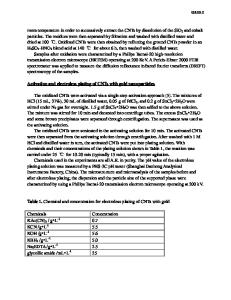GeTe-filled Carbon Nanotubes for Data Storage Applications
- PDF / 453,637 Bytes
- 6 Pages / 612 x 792 pts (letter) Page_size
- 22 Downloads / 385 Views
1251-H06-03
GeTe-filled Carbon Nanotubes for Data Storage Applications Cristina E. Giusca1, Vlad Stolojan1, Jeremy Sloan2, Hidetsugu Shiozawa1 and S. Ravi P. Silva1 1 Nanoelectronics Centre, Advanced Technology Institute, University of Surrey, Guildford, GU2 7XH, United Kingdom 2 Department of Physics, University of Warwick, Coventry CV4 7AL, United Kingdom ABSTRACT By virtue of their unique electronic properties, nanometer-diameter sized single-walled carbon nanotubes represent ideal candidates to function as active parts of nanoelectronic memory storage devices. We show for the first time that GeTe, a phase change material, currently considered to be one of the most promising materials for data-storage applications, can efficiently be encapsulated within single-walled carbon nanontubes of 1.4 nm diameter. Structural investigations on the encapsulated GeTe nanowires have been carried out by high resolution transmission electron microscopy. The electronic interactions between the filling material and the host nanotube have been examined using ultraviolet photoelectron spectroscopy experiments and show that the electronic structure of the encapsulating nanotube and that of the encased filling are not perturbed by the presence of each of the other component. The newly formed hybrids offer potential to operate as active elements in non-volatile electronic memory storage devices.
INTRODUCTION The past several decades have witnessed a constant growth in the data storage capabilities of silicon-based electronics but it is becoming increasingly tougher to keep up with the industry’s long-term trends towards miniaturisation because of fundamental physical limitations preventing current designs from functioning reliably at the nanometer scale. Molecular electronics has the potential to overcome these limitations by providing new designs for building memory devices from the bottom-up using individual molecules. By virtue of their unique electronic properties, as well as chemical inertness and mechanical toughness, nanometer-diameter sized single-walled carbon nanotubes (SWNTs) represent ideal candidates to function as active components of nanoelectronic memory storage devices. Indeed, designs of a carbon nanotube-based electromechanical universal memory [1], as well as a non-volatile random access memory (RAM) using carbon nanotubes (CNTs) for molecular computing have been proposed [2], showing that these devices present competitive capabilities to existing memory technologies. In addition to the remarkable physical and chemical properties, due to unique dimensions and geometry, the central cavity of SWNTs has been shown to serve as a template for the controlled growth of one dimensional crystals, providing an unparalleled opportunity of engineering structures with sometimes entirely novel co-ordinations and stereochemistry [3]. A wide range of organic, as well as inorganic materials have been shown to fill the inner cores of SWNTs [4-6], however no reports of phase change materials encapsulated within SWNTs exist. Numerous
Data Loading...











